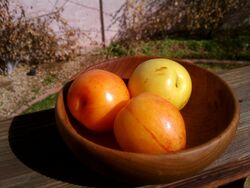Biology:Lemon plum
A lemon plum is a rare fruit imported from Chile , which is becoming increasingly popular in the United States and Canada.
It resembles the taste of a plum, and is very sweet and juicy. The fruit has a similar shape to that of a lemon, except one end is rounded and the other end has a point. Named lemon plums because of their color, rather than the flavor, when unripe, they have a bright yellow color, and are sour. As they ripen, their color changes from yellow to a golden orange and then finally to a dark reddish-purple when ripe. They have a slightly floral, very fragrant smell. Like all drupes, this plum has an inedible pit in the center.
Lemon plums are best eaten fresh, out-of-hand. They can be eaten when they are still yellow, when their flesh is still crisp and slightly acidic or when the plum has fully ripened.
The lemon plum is an excellent source of vitamin A, vitamin C, and fiber.
Their peak availability in the United States is very short and is typically within February, outside the range of May to October for domestic plum season.[1] It has a low chilling hour requirement, making it suitable for coastal areas and Southern California, and ripens in August in Central California, hanging on the tree until the end of the month.
This plum variety is possibly but unlikely to be the one called 'Inca', introduced by Luther Burbank in 1919 and grown in very limited quantities in the United States. L. E. Cooke Co., a wholesale grower of bareroot fruit trees for orchards and home gardens, lists it in their catalog.[2]
References


